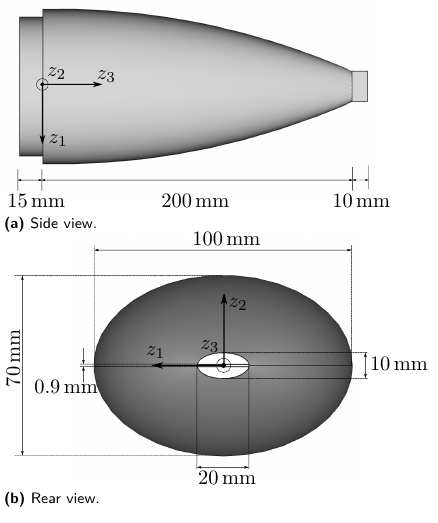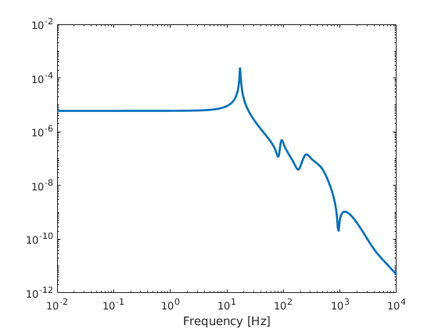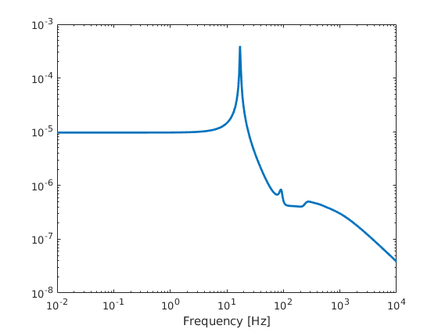m (Small corrections and additions.) |
|||
| Line 1: | Line 1: | ||
| − | {{preliminary}} <!-- Do not remove --> |
||
[[Category:benchmark]] |
[[Category:benchmark]] |
||
[[Category:ODE]] |
[[Category:ODE]] |
||
| Line 18: | Line 17: | ||
==Description== |
==Description== |
||
| − | Todays autonomous underwater vehicles (AUVs) are |
+ | Todays [[wikipedia:Autonomous_underwater_vehicle|autonomous underwater vehicles]] (AUVs) are a source of noise pollution and inefficiency due to their screw propeller driven design. |
| + | The evolution of fish has, on the other hand, optimized their underwater efficiency and agility over millennia. |
||
| + | The adaption of fish-like drive systems for AUVs is therefore a promissing choice. |
||
==Model Description== |
==Model Description== |
||
| + | This model describes the silicon body of an artificial fishtail supported by a central carbon beam. |
||
| − | This model describes the silicon body of an artificial fishtail supported by a central carbon beam. The rear part of the fish-body without the fins is modeled as as a 3d FEM model using linear elasticity. In the current stage of modeling the tail is rigidly mounted in the front, the states in <math>x</math> represent the displacements of the finite element degrees of freedom. The fish-like locomotion is enabled by pumping air between two sets of pressure chambers in the left and right halves of the tail. The single input <math>u</math> of the system is thus the pumping pressure. The outputs are displacements of certain surface points. There are two variants of the model. The first has only three outputs representing the displacements of the point of interest, the rear tip of the carbon beam, in the three spatial directions. For the second variant 6 additional points on the flank are added as outputs. |
||
| + | The rear part of the fish-body without the fins is modeled as as a 3D FEM model using linear elasticity. |
||
| + | In the current stage of modeling the tail is rigidly mounted in the front, the states in <math>x</math> represent the displacements of the finite element degrees of freedom. |
||
| + | The fish-like locomotion is enabled by pumping air between two sets of pressure chambers in the left and right halves of the tail. |
||
| + | The single input <math>u</math> of the system is thus the pumping pressure. |
||
| + | The outputs are displacements of certain surface points. |
||
| + | There are two variants of the model. |
||
| + | The first has three outputs representing the displacements of the point of interest, the rear tip of the carbon beam, in the three spatial directions. |
||
| + | For the second variant six additional points <math>(z_1,z_2,z_3)</math> on the flank are added as outputs, yielding a total of 21 outputs. |
||
| Line 60: | Line 69: | ||
|} |
|} |
||
| − | Note that the POI is the last row in this table and in Cp_ext in the data files (see below) |
+ | Note that the POI (Point of Interest) is the last row in this table and in Cp_ext in the data files (see below). |
| + | The additional outputs show two effects. |
||
| + | On the one hand, for purely input output related reduction methods they avoid drastic deviations on the interior states, |
||
| + | on the other hand they show a smoothing effect for the models transfer function. |
||
==Origin== |
==Origin== |
||
| Line 66: | Line 78: | ||
==Data== |
==Data== |
||
| − | + | The model is based on the the finite element package [https://www.firedrakeproject.org Firedrake] and uses the material parameters: |
|
{| class="wikitable" style="margin: auto;" |
{| class="wikitable" style="margin: auto;" |
||
|+ style="caption-side:bottom;"| |
|+ style="caption-side:bottom;"| |
||
| Line 155: | Line 167: | ||
title = {Matrices for an Artificial Fishtail}, |
title = {Matrices for an Artificial Fishtail}, |
||
howpublished = {hosted at {MORwiki} -- Model Order Reduction Wiki}, |
howpublished = {hosted at {MORwiki} -- Model Order Reduction Wiki}, |
||
| ⚫ | |||
year = 2019, |
year = 2019, |
||
doi = {10.5281/zenodo.2558728} |
doi = {10.5281/zenodo.2558728} |
||
| Line 166: | Line 177: | ||
title = {Modeling and Motion Planning for an Artificial Fishtail}, |
title = {Modeling and Motion Planning for an Artificial Fishtail}, |
||
journal = {IFAC-PapersOnLine}, |
journal = {IFAC-PapersOnLine}, |
||
| − | year = 2018, |
||
volume = 51, |
volume = 51, |
||
number = 2, |
number = 2, |
||
| ⚫ | |||
pages = {319--324}, |
pages = {319--324}, |
||
doi = {10.1016/j.ifacol.2018.03.055}, |
doi = {10.1016/j.ifacol.2018.03.055}, |
||
| Line 176: | Line 187: | ||
==References== |
==References== |
||
<references> |
<references> |
||
| − | <ref name="SieKM18">D. Siebelts, A. Kater, T. Meurer, <span class="plainlinks">[https://doi.org/doi:10.1016/j.ifacol.2018.03.055 Modeling and |
+ | <ref name="SieKM18">D. Siebelts, A. Kater, T. Meurer, <span class="plainlinks">[https://doi.org/doi:10.1016/j.ifacol.2018.03.055 Modeling and Motion Planning for an Artificial Fishtail]</span>, IFAC-PapersOnLine (9th Vienna International Conference on Mathematical Modelling) 51(2): 319--324, 2018.</ref> |
</references> |
</references> |
||
Revision as of 15:18, 4 March 2019
Description
Todays autonomous underwater vehicles (AUVs) are a source of noise pollution and inefficiency due to their screw propeller driven design. The evolution of fish has, on the other hand, optimized their underwater efficiency and agility over millennia. The adaption of fish-like drive systems for AUVs is therefore a promissing choice.
Model Description
This model describes the silicon body of an artificial fishtail supported by a central carbon beam.
The rear part of the fish-body without the fins is modeled as as a 3D FEM model using linear elasticity.
In the current stage of modeling the tail is rigidly mounted in the front, the states in  represent the displacements of the finite element degrees of freedom.
The fish-like locomotion is enabled by pumping air between two sets of pressure chambers in the left and right halves of the tail.
The single input
represent the displacements of the finite element degrees of freedom.
The fish-like locomotion is enabled by pumping air between two sets of pressure chambers in the left and right halves of the tail.
The single input  of the system is thus the pumping pressure.
The outputs are displacements of certain surface points.
There are two variants of the model.
The first has three outputs representing the displacements of the point of interest, the rear tip of the carbon beam, in the three spatial directions.
For the second variant six additional points
of the system is thus the pumping pressure.
The outputs are displacements of certain surface points.
There are two variants of the model.
The first has three outputs representing the displacements of the point of interest, the rear tip of the carbon beam, in the three spatial directions.
For the second variant six additional points  on the flank are added as outputs, yielding a total of 21 outputs.
on the flank are added as outputs, yielding a total of 21 outputs.

|

|

|
|---|---|---|
| 0.05 | 0.0 | 0.0 |
| 0.0474526 | 0.0 | 0.0599584 |
| 0.04032111 | 0.0 | 0.105274 |
| 0.0326229 | 0.0 | 0.136726 |
| 0.0250675 | 0.0 | 0.16107 |
| 0.0168069 | 0.0 | 0.183588 |
| 0.0 | 0.0 | 0.21 |
Note that the POI (Point of Interest) is the last row in this table and in Cp_ext in the data files (see below). The additional outputs show two effects. On the one hand, for purely input output related reduction methods they avoid drastic deviations on the interior states, on the other hand they show a smoothing effect for the models transfer function.
Origin
The model was setup and computed at the chair of automatic control at CAU Kiel and first presented in [1].
Data
The model is based on the the finite element package Firedrake and uses the material parameters:
| Part | Parameter | Value | Unit |

|

|

| |
| Hull | 
|

|

|

|

|
||

|

|

| |
| Beam | 
|

|

|

|

|
||
| Rayleigh damping | 
|

|

|

|

|

|
Dimensions
System structure:
System dimensions:
 ,
,
 ,
,
 ,
,
 ,
,
 ,
with
,
with  and
and  .
.
The internal damping is modeled as Rayleigh damping  using the coefficients from the table above.
using the coefficients from the table above.
System variants:
 :
:  Cp in the data files,
Cp in the data files, :
:  Cp_ext in the data files.
Cp_ext in the data files.
Remarks
- Physically meaningful inputs are of dimension
 . As an example, a step signal with around
. As an example, a step signal with around  Pa leads to a horizontal POI displacement of about
Pa leads to a horizontal POI displacement of about  cm.
cm. - The interesting operation frequencies are in the range between
 Hz and
Hz and  Hz.
Hz. - If required, the finite element mesh behind the model and a CSV file with the output locations are available separately.
Citation
To cite this benchmark, use the following references:
- For the benchmark itself and its data:
@Misc{SieKM19,
author = {Siebelts, D. and Kater, A. and Meurer, T. and Andrej, J.},
title = {Matrices for an Artificial Fishtail},
howpublished = {hosted at {MORwiki} -- Model Order Reduction Wiki},
year = 2019,
doi = {10.5281/zenodo.2558728}
}
- For the background on the benchmark:
@Article{SieKM18,
author = {Siebelts, D. and Kater, A. and Meurer, T.},
title = {Modeling and Motion Planning for an Artificial Fishtail},
journal = {IFAC-PapersOnLine},
volume = 51,
number = 2,
year = 2018,
pages = {319--324},
doi = {10.1016/j.ifacol.2018.03.055},
publisher = {Elsevier {BV}}
}
References
- ↑ D. Siebelts, A. Kater, T. Meurer, Modeling and Motion Planning for an Artificial Fishtail, IFAC-PapersOnLine (9th Vienna International Conference on Mathematical Modelling) 51(2): 319--324, 2018.




